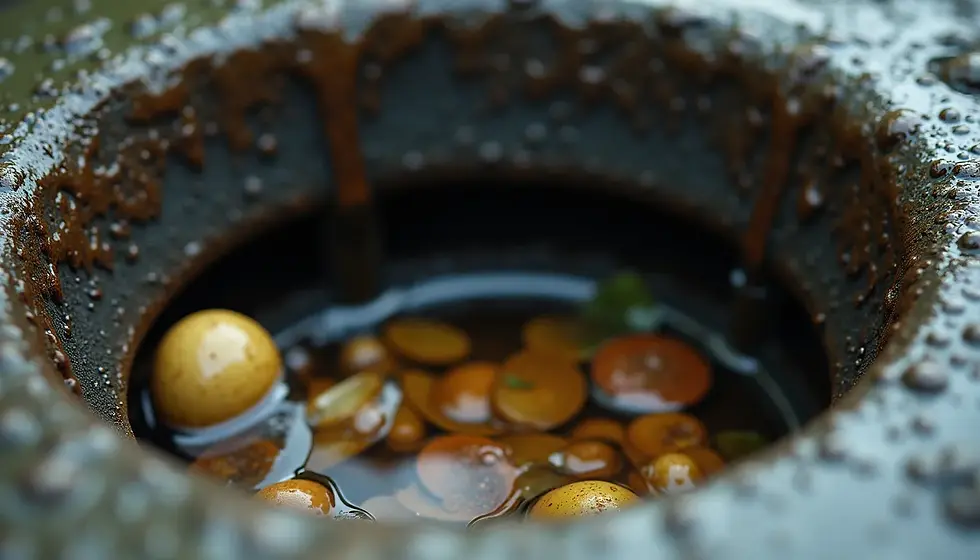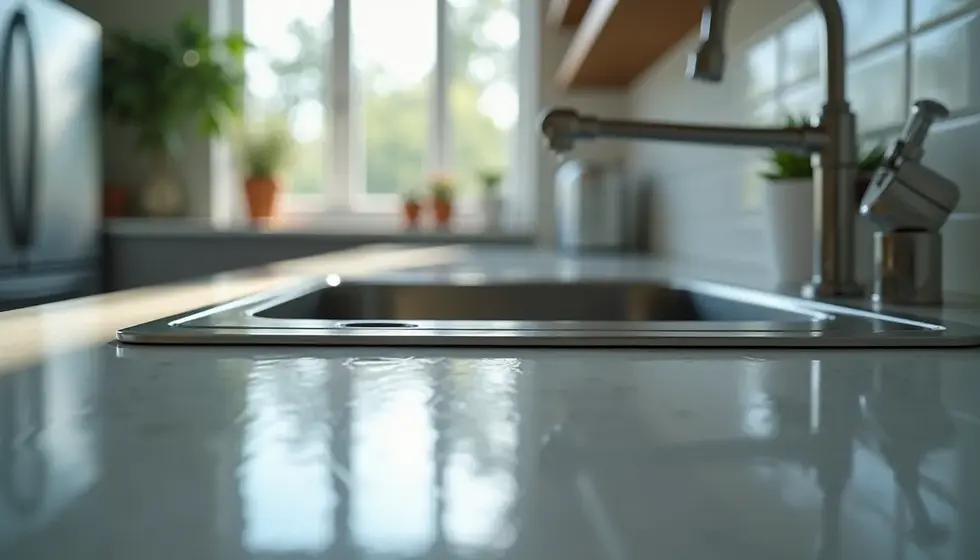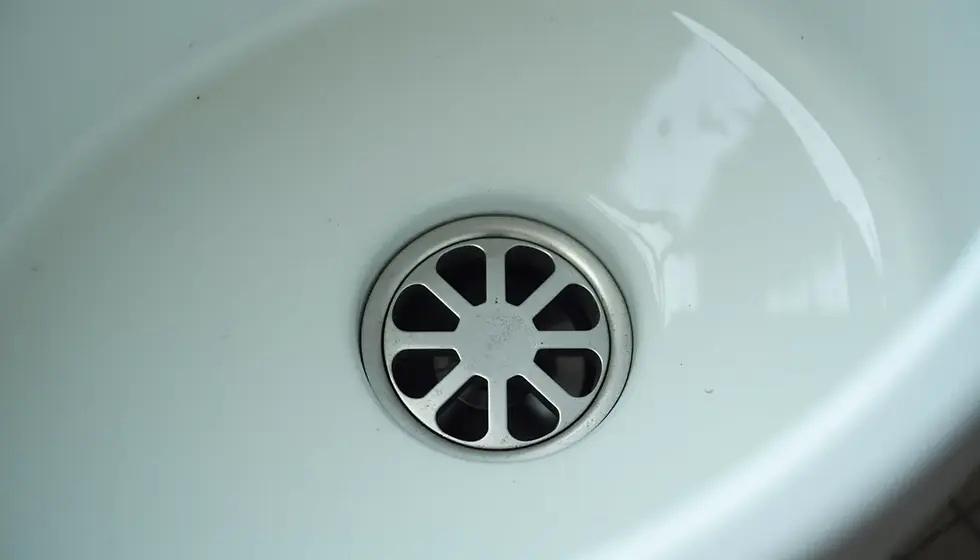How to Get Rid of Drain Flies: A Complete Guide 🪠
- Mei-Lin Arora

- Sep 1
- 9 min read
Updated: Sep 13
If you’ve noticed tiny, fuzzy moth-like flies hovering near your sink or shower, you’re dealing with drain flies. This guide explains exactly how to get rid of drain flies step by step—whether they’re in your kitchen sink, bathroom shower, or floor drains. You’ll learn how to identify them, find their breeding source, and clean the slimy biofilm where they lay eggs. By the end, you’ll know not just how to get rid of drain flies in bathrooms and kitchens, but also how to prevent them from coming back with a simple weekly routine.
Drain Flies 101: What You’re Dealing With (and Why Sprays Don’t Work)
Drain flies (also called moth flies or psychodid flies) are 2–5 mm long with fuzzy, moth-like wings. They’re slow fliers that rest on walls near sinks, tubs, floor drains, or sump areas. Adults themselves are mostly harmless; the real issue is the gelatinous biofilm (a mix of food grease, skin oils, hair, soap scum, and bacteria) inside drains, P-traps, and overflows. That slime is where eggs are laid and larvae feed. If you just spray the adults you see, the source keeps producing new flies every 24–48 hours. Translation: fix the biofilm and you fix the flies.
Key life-cycle basics you can use to your advantage:
Eggs → larvae → pupae → adults: development happens in wet, gunky film; adults then emerge into the room.
Adults live ~1–2 weeks and don’t travel far; if you see them in the bathroom, the breeding site is usually that bathroom’s plumbing (not the neighbor’s).
Any pocket of consistent moisture + organic gunk can breed them: sink overflows, P-traps, shower/tub weep holes, floor drains, dishwasher/AC condensate lines, even cracks in old cast-iron or under-slab lines where organic matter collects.
Quick Identification: Drain Fly vs. Fruit Fly vs. Fungus Gnat
Before you start, confirm your opponent:
Drain fly (moth fly): fuzzy, triangular/moth-like wings; flies in short hops; hangs near walls/drains; crush leaves a smudge.
Fruit fly: tan/yellow, often with red eyes; seen near fruit, compost, recycling; very active fliers.
Fungus gnat: slender, mosquito-ish; more common near houseplants and damp soil.
If your flies are hovering over fruit or trash, clean those sources first. If they’re hugging the sink, shower, or floor drain, this playbook is for you.
How to Locate the Breeding Source (10–20 Minutes)
You’ll save hours if you identify which fixture is breeding. Two fast tests:
The Tape Test (Overnight):
At night, dry the suspect drain’s rim. Place strips of clear packing tape sticky-side down over half the opening, leaving airflow.
In the morning, check for stuck adults that emerged overnight. If you catch several, that drain is likely the source.
The Cup Test (Larvae Check):
Tape a clear cup over a dry drain opening (leave a small gap for air). Larvae/ pupae may crawl upward and get trapped; adults may emerge and accumulate.
No captures? Test other drains (shower, tub overflow, floor drain, laundry standpipe, A/C condensate line, dishwasher air gap).
Keep going until you find the one or two drains with activity. That’s where you’ll focus 90% of your work.

The Core Method (Works in Kitchens, Bathrooms, and Floor Drains)
This is your no-nonsense, minimal-chemical plan to remove the biofilm that fuels drain flies. It’s the same sequence pros follow.
Step 1 — Mechanical Cleaning (Don’t Skip)
Remove the stopper/strainer. Pull up hair, lint, and sludge with a plastic drain cleaning strip or gloved fingers.
Scrub the throat (the first 6–12 inches). Use a long, stiff bottle brush or a flexible drain brush with warm, soapy water. Rotate and push/pull to scour the film.
Clean the overflow channel (bathroom sinks/tubs): insert a narrow brush into the overflow hole and scrub with hot, soapy water.
Shower/tub: unscrew the cover plate; scrub under it and down into the riser.
Floor drains: remove the grate; scrub the cup/trap and the sidewalls where slime clings.
Step 2 — Flush with Hot (Not Boiling) Water
Run hot tap water (120–140°F / 49–60°C) for 1–2 minutes to rinse loosened gunk.
Avoid boiling water directly into PVC—they can soften/distort under sustained heat. If you’re careful with kettle water, pour slowly in short bursts and follow with warm tap water.
Step 3 — Apply a Foaming Bio-Enzyme or Surfactant Cleaner
Use a foaming drain cleaner that targets organic film (often enzyme or surfactant based). The foam contacts the upper walls of the drain where biofilm clings—liquids alone rush past.
Follow the label for dwell time (commonly 30–60 minutes). Apply to the overflow channel too.
Repeat nightly for 3–7 days until adults stop appearing.
Step 4 — Restore the Water Seal and Dry What Should Be Dry
P-traps must stay wet (they block sewer gas). If a drain is rarely used, run water weekly to keep the trap filled.
Surrounding surfaces should be dry after cleaning—wipe backsplash seams, counter lips, and around the escutcheon to remove misted residue that can feed biofilm.
Step 5 — Intercept Adults while the Colony Collapses
Vacuum visible adults from walls and tile (they’re slow and easy to catch).
Use UV + sticky traps overnight near the problem drain to cut adult numbers fast.
Avoid broad insecticide aerosols indoors—they don’t fix the source and can scatter flies to other rooms.
Most homeowners see a big drop in adults by Day 3–5, and the all-clear by two weeks, assuming you found every source and kept up the foam cycles.

How to Get Rid of Drain Flies in the Bathroom
Bathroom sinks, tub/shower drains, and floor drains are the top culprits. Here’s a targeted bathroom plan:
Sink/Vanity: Remove the pop-up stopper and scrub it separately—gunk hides under the cap. Brush the drain throat hard; use a narrow brush up the overflow channel with foaming cleaner.
Tub/Shower: Clean the cover plate; scrub under it and down the riser. If there’s a hair catcher, remove and clean it thoroughly.
Tile Weep Channels: Some showers have weep holes near the drain grate; flush them with warm soapy water to dislodge sludge.
Floor Drains: Remove the grate; scrub the cup and sides; foam up to coat surfaces; refill the trap with water afterward.
Ventilation: Run the bathroom fan during/after showers; high humidity slows drying and encourages biofilm.
If you want a university-level reference on moth/drain flies (biology + control), more info on this here: https://entomology.ca.uky.edu/ef615
How to Get Rid of Fruit Flies in Drains in the Kitchen
Kitchen drains can breed both drain flies and fruit flies, especially if you cook with oils or leave organics in the disposal.
Garbage Disposal Reset:
Kill power at the switch/breaker. Shine a light down the throat.
Scrub the rubber splash guard (it harbors grease film). Pop it out (if removable) and soak in soapy water; scrub thoroughly.
With a long bottle brush, scrub the disposal throat and upper chamber walls. Rinse with hot water.
Foam the Upper Walls:
Apply foaming enzyme/surfactant cleaner to the disposal and the adjacent sink drain; coat the upper 6–12 inches and the underside of the splash guard.
Air Gap & Dishwasher Inlet:
Clean the air gap (the small cap near the faucet) and the short hose leading down to the disposal or drain. Built-up slime here is a common missed source.
Degrease the P-trap (if needed):
If drainage is slow and greasy, have a plumber perform a trap and wall line clean-out. Heavy grease in horizontal runs can keep producing flies even after you clean the throat.
Fruit Fly Extras:
Remove attractants (ripe fruit, sticky recycling). Keep a tight lid on compost. A few apple-cider vinegar traps can catch stragglers, but don’t confuse these with drain-fly control—you must still address the biofilm.
Specialty Zones People Often Forget (and That Keep Flies Coming Back)
Laundry Standpipes: The vertical pipe behind the washer can accumulate soap scum and lint. Foaming cleaner + a long brush does wonders. Keep the trap wet.
A/C or Dehumidifier Condensate Lines: These drip water into a floor drain or condensate pump. Slime builds up in line traps and pump reservoirs—clean or replace per manufacturer instructions.
Sump Pits & Utility Sinks: Rarely cleaned, constantly wet. Vacuum out slime, scrub the liner walls, and keep a lid on the pit.
Under-slab or Old Cast-Iron Lines: If you’ve done everything and flies return quickly, a cracked line could be seeding a sub-floor breeding pocket. This is a pro situation—camera inspection & repair.
Exact Products & Chemistry (Choosing Safely)
Foaming enzyme/surfactant cleaners: Great first choice; they break down organic film where larvae live and are designed for contact on vertical surfaces.
Bacterial digesters (bio-cleaners): Useful in maintenance; some are slower but excellent for ongoing control.
Bleach? As a standalone, it rarely works—bleach reacts quickly with organics, loses strength fast, and doesn’t cling to upper walls.
Caustic openers (lye etc.): Designed for clogs, not routine fly control; can be harsh on pipes and risky indoors.
Never mix chemicals. Especially bleach + ammonia or bleach + acids (vinegar, descalers). Toxic gases form—don’t do it.
“Two-Week Win” Schedule (What to Do on Each Day)
Day 1 – Source Hunt
Run tape tests on suspect drains.
Identify which drains are producing flies.
Day 1 Night
Scrub the drain mechanically with a brush.
Flush with hot water.
Apply foaming cleaner to the drain walls and overflows.
Days 2–4
Apply foaming cleaner nightly.
Vacuum visible adults morning and evening.
Run the bathroom fan after showers.
Keep counters and drain lips dry.
Day 5
Re-test with tape on the suspect drains.
If captures are down by more than 80%, you’re on track.
If not, add adjacent drains (overflow, air gap, or floor drain) to the cleaning regimen.
Days 6–10
Continue foaming nightly where adult activity remains.
Refill water in rarely used traps to keep them functional.
Days 11–14
You should now see near-zero adults.
Switch to a maintenance routine:
Weekly quick brush scrub.
One foaming shot in the original problem drain.
Prevent the Rebound: Simple Weekly Routine (5–8 Minutes)
Brush the first 6–12 inches of the problem drain (and any drains right next to it).
Foam once (small dose) on Sunday night; include overflows in bathrooms.
Keep traps wet in floor drains and standpipes; 1–2 cups of water weekly.
Wipe dry the drain lip, counter seam, and backsplash corners after use.
Run the bath fan 15–20 minutes after showers to reduce humidity.

Troubleshooting: If You Still See Flies After a Week
You missed a source. Check floor drains, the sink overflow, air gap, laundry standpipe, or a condensate line.
Foam isn’t contacting the walls. Make sure the product foams; liquids alone streak past. Scrub first, then foam.
Trap is drying out. Rarely used drains need a weekly top-up; a dry trap can draw flies from the line into your space.
Under-slab issue. If adults keep appearing with no obvious source and you smell sewage, it’s time for a camera inspection of the line.
How to Get Rid of Drain Flies in Bathroom: A Mini-Checklist
Remove sink stopper; scrub stopper and throat.
Brush the overflow (this hides sludge).
Tub/shower: unscrew cover plate, scrub under and down riser; foam.
Floor drain: lift grate, brush cup/trap walls; foam; refill trap.
Run fan after showers; towel-dry corners and caulk lines.
Repeat foam nightly for 3–7 days; vacuum stragglers.
How to Get Rid of Drain Flies (Kitchen): A Mini-Checklist
Clean disposal splash guard (remove and scrub both sides).
Brush disposal throat + upper chamber; foam walls.
Clean dishwasher air gap and inlet hose area.
Degrease slow, greasy traps (consider a plumber clean-out).
Empty compost nightly; rinse recycling.
Foam nightly for 3–7 days; keep sink rim and caulk line dry.
Safety, Pets, and When to Call a Pro 🧪
Use ventilation when applying cleaners; wear gloves if you’re skin-sensitive.
Never mix chemicals; store products away from kids and pets.
Call a pro if you suspect leaking/ cracked lines, repeated rebounds after a thorough two-week regimen, or if drains are gurgling/slow despite cleaning (you may have a bigger drain or vent-stack issue).
FAQs (From “What If I Rent?” to “Do Traps Really Matter?”)
Do I need pesticides?
Rarely. Drain flies are best solved by removing the slime (mechanical + foam). Insecticides kill adults you can already vacuum; they don’t fix the source.
Can boiling water solve it?
Boiling water can help loosen light grease, but it won’t stick to upper drain walls. Use foaming cleaners and mechanical brushing for a real fix, and be careful with PVC.
What if I’m a renter?
Do the source hunt (tape tests) and the throat/overflow scrub + foam. If floor drains or standpipes are involved or you suspect a trap/line issue, document the problem and ask your landlord to service the plumbing.
How long until they’re gone?
Most homes see a big drop by Day 3–5 and “gone” by 2 weeks when all sources are cleaned and foamed.
Can I just use bleach or vinegar?
Bleach loses strength quickly and doesn’t cling to upper walls; vinegar helps with minerals but not heavy grease. Both are limited. Use a foaming cleaner designed for organic build-up.
Your One-Page Action Plan (Copy/Paste to Notes)
Confirm it’s drain flies (not fruit flies or fungus gnats).
Use tape tests to locate the breeding drain(s).
Brush scrub the throat/overflow or grate/sidewalls (mechanical first).
Hot water flush (not boiling for PVC).
Foam the drain walls & overflow every night for 3–7 days.
Vacuum adults; set one UV sticky trap near the hot zone.
Keep traps wet (for floor drains, standpipes) and surfaces dry.
After the all-clear, weekly brush + quick foam in the original hot zone.
Stick to that sequence and you’ll break the life cycle fast, without turning the kitchen or bathroom into a chemistry lab. 🧼



Comments